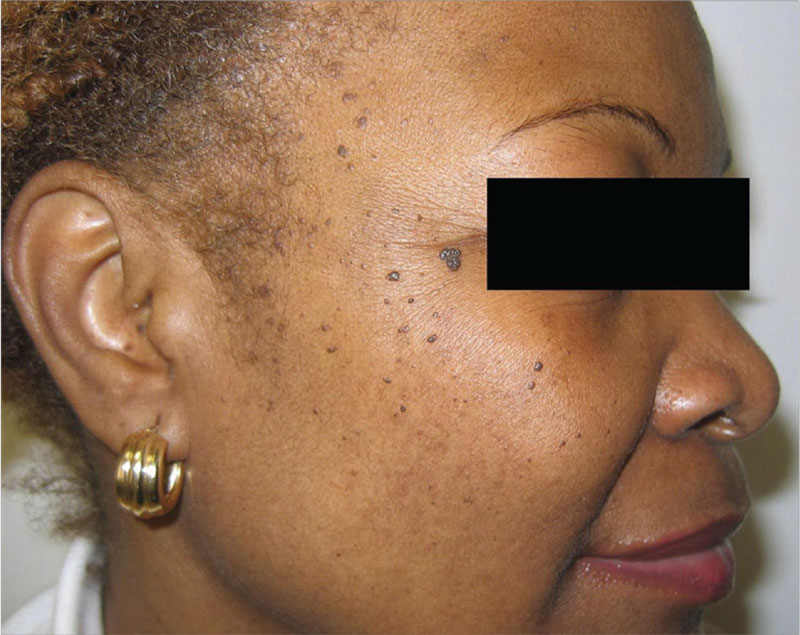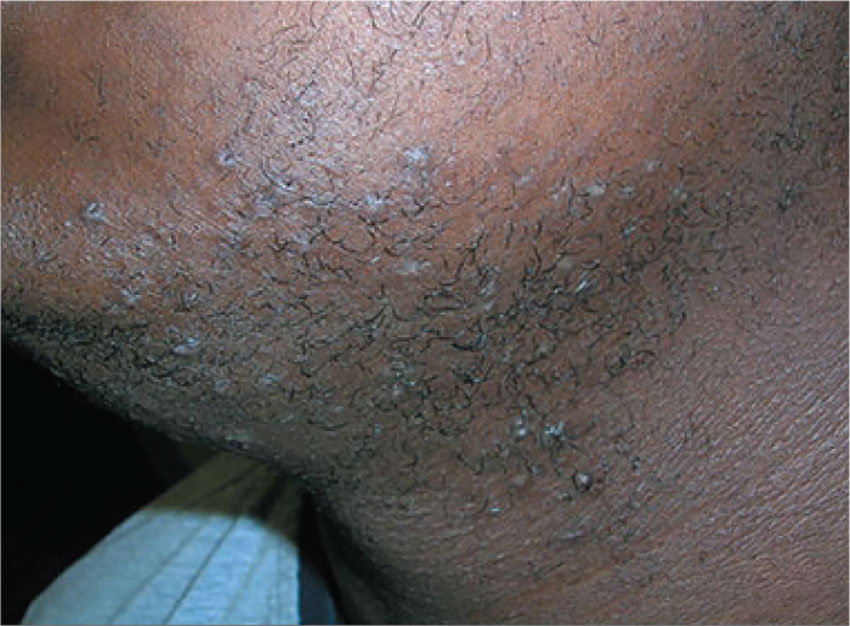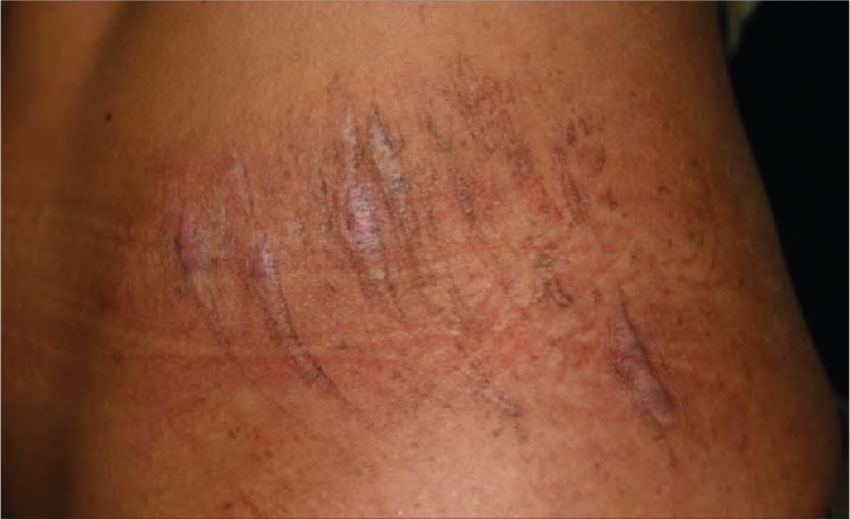User login
1. This patient is concerned about the numerous long-standing “moles” on her face. Only occasionally pruritic, they are otherwise asymptomatic. Nevertheless, the patient wants them investigated and removed.

Diagnosis: Dermatosis papulosa nigra (DPN) is a benign condition that presents as multiple brown to dark-brown 1- to 5-mm papules on the face, neck, and trunk. The lesions are a sign of aging in darker skinned patients and do not require treatment. They can, however, be safely, easily, and effectively removed. Both electrodesiccation and KTP (532 nm) laser have comparable efficacy in the removal of DPN, according to a 2009 study published in the American Journal of Dermatologic Surgery. Without use of anesthetics, the KTP laser is preferred for patient comfort.
For more information, see “Skin of Color: Dermatosis Papulosa Nigra Removal.” Dermatology News. February 1, 2012.
2. A 17-year-old African-American boy likes to keep his face clean-shaven, but his skin becomes irritated every time he shaves. He states that his father also has this problem, but doesn’t have a solution.

Diagnosis: Pseudofolliculitis is a common skin condition affecting hair-bearing areas of the body that are shaved. It develops when the free end of a tightly coiled hair reenters the skin after shaving, causing a foreign-body–like inflammatory reaction. Tightly curled hair has a greater tendency to pierce the follicle and the surface of the skin, explaining the relative predominance of pseudofolliculitis in patients of African descent; at least half of black men who shave develop the condition.
For more information, see “Bumps in beard area.” J Fam Pract. 2015 November;64(11).
3. A 15-year-old African-American boy presents with a two-month history of hair loss and pruritic papules on the back of his head that developed after a barber shaved the area. There are two dozen 1- to 2-mm papules on his posterior neck and occipital scalp with areas of focal crusting. The patient had a similar episode a year ago after shaving the same area, but those papules cleared after one month of applying rubbing alcohol.

Diagnosis: This patient’s diagnosis is acne keloidalis nuchae (AKN), a chronic folliculitis characterized by smooth, dome-shaped papules on the posterior scalp and neck that become confluent and form firm papules and hairless, keloid-like plaques. Seen almost exclusively in young, postpubescent African-American males, the condition is often asymptomatic, although some patients complain of itching in the affected area.
For more information, see “Scalp papules in a teenage boy.” J Fam Pract. 2017 March;66(3).
4. Several years after a motorcycle accident and resulting road rash, this 23-year-old Hispanic woman is left with complex scars. She experiences pruritus, pain, and hypersensitivity and is seeking relief.

Diagnosis: Often confused with hypertrophic scars, keloids are benign overgrowths of scar tissue that can occur months to years after skin trauma. They are most common in those ages 10 to 30, with a higher incidence among blacks, Hispanics, and Asians. Although the exact etiology of keloids is unknown, they are related to aberrant collagen production and breakdown in wound healing.
For more information, see “Laser treatment of scars and keloids.” Cosmet Dermatol. 2012;25:318-325.
1. This patient is concerned about the numerous long-standing “moles” on her face. Only occasionally pruritic, they are otherwise asymptomatic. Nevertheless, the patient wants them investigated and removed.

Diagnosis: Dermatosis papulosa nigra (DPN) is a benign condition that presents as multiple brown to dark-brown 1- to 5-mm papules on the face, neck, and trunk. The lesions are a sign of aging in darker skinned patients and do not require treatment. They can, however, be safely, easily, and effectively removed. Both electrodesiccation and KTP (532 nm) laser have comparable efficacy in the removal of DPN, according to a 2009 study published in the American Journal of Dermatologic Surgery. Without use of anesthetics, the KTP laser is preferred for patient comfort.
For more information, see “Skin of Color: Dermatosis Papulosa Nigra Removal.” Dermatology News. February 1, 2012.
2. A 17-year-old African-American boy likes to keep his face clean-shaven, but his skin becomes irritated every time he shaves. He states that his father also has this problem, but doesn’t have a solution.

Diagnosis: Pseudofolliculitis is a common skin condition affecting hair-bearing areas of the body that are shaved. It develops when the free end of a tightly coiled hair reenters the skin after shaving, causing a foreign-body–like inflammatory reaction. Tightly curled hair has a greater tendency to pierce the follicle and the surface of the skin, explaining the relative predominance of pseudofolliculitis in patients of African descent; at least half of black men who shave develop the condition.
For more information, see “Bumps in beard area.” J Fam Pract. 2015 November;64(11).
3. A 15-year-old African-American boy presents with a two-month history of hair loss and pruritic papules on the back of his head that developed after a barber shaved the area. There are two dozen 1- to 2-mm papules on his posterior neck and occipital scalp with areas of focal crusting. The patient had a similar episode a year ago after shaving the same area, but those papules cleared after one month of applying rubbing alcohol.

Diagnosis: This patient’s diagnosis is acne keloidalis nuchae (AKN), a chronic folliculitis characterized by smooth, dome-shaped papules on the posterior scalp and neck that become confluent and form firm papules and hairless, keloid-like plaques. Seen almost exclusively in young, postpubescent African-American males, the condition is often asymptomatic, although some patients complain of itching in the affected area.
For more information, see “Scalp papules in a teenage boy.” J Fam Pract. 2017 March;66(3).
4. Several years after a motorcycle accident and resulting road rash, this 23-year-old Hispanic woman is left with complex scars. She experiences pruritus, pain, and hypersensitivity and is seeking relief.

Diagnosis: Often confused with hypertrophic scars, keloids are benign overgrowths of scar tissue that can occur months to years after skin trauma. They are most common in those ages 10 to 30, with a higher incidence among blacks, Hispanics, and Asians. Although the exact etiology of keloids is unknown, they are related to aberrant collagen production and breakdown in wound healing.
For more information, see “Laser treatment of scars and keloids.” Cosmet Dermatol. 2012;25:318-325.
1. This patient is concerned about the numerous long-standing “moles” on her face. Only occasionally pruritic, they are otherwise asymptomatic. Nevertheless, the patient wants them investigated and removed.

Diagnosis: Dermatosis papulosa nigra (DPN) is a benign condition that presents as multiple brown to dark-brown 1- to 5-mm papules on the face, neck, and trunk. The lesions are a sign of aging in darker skinned patients and do not require treatment. They can, however, be safely, easily, and effectively removed. Both electrodesiccation and KTP (532 nm) laser have comparable efficacy in the removal of DPN, according to a 2009 study published in the American Journal of Dermatologic Surgery. Without use of anesthetics, the KTP laser is preferred for patient comfort.
For more information, see “Skin of Color: Dermatosis Papulosa Nigra Removal.” Dermatology News. February 1, 2012.
2. A 17-year-old African-American boy likes to keep his face clean-shaven, but his skin becomes irritated every time he shaves. He states that his father also has this problem, but doesn’t have a solution.

Diagnosis: Pseudofolliculitis is a common skin condition affecting hair-bearing areas of the body that are shaved. It develops when the free end of a tightly coiled hair reenters the skin after shaving, causing a foreign-body–like inflammatory reaction. Tightly curled hair has a greater tendency to pierce the follicle and the surface of the skin, explaining the relative predominance of pseudofolliculitis in patients of African descent; at least half of black men who shave develop the condition.
For more information, see “Bumps in beard area.” J Fam Pract. 2015 November;64(11).
3. A 15-year-old African-American boy presents with a two-month history of hair loss and pruritic papules on the back of his head that developed after a barber shaved the area. There are two dozen 1- to 2-mm papules on his posterior neck and occipital scalp with areas of focal crusting. The patient had a similar episode a year ago after shaving the same area, but those papules cleared after one month of applying rubbing alcohol.

Diagnosis: This patient’s diagnosis is acne keloidalis nuchae (AKN), a chronic folliculitis characterized by smooth, dome-shaped papules on the posterior scalp and neck that become confluent and form firm papules and hairless, keloid-like plaques. Seen almost exclusively in young, postpubescent African-American males, the condition is often asymptomatic, although some patients complain of itching in the affected area.
For more information, see “Scalp papules in a teenage boy.” J Fam Pract. 2017 March;66(3).
4. Several years after a motorcycle accident and resulting road rash, this 23-year-old Hispanic woman is left with complex scars. She experiences pruritus, pain, and hypersensitivity and is seeking relief.

Diagnosis: Often confused with hypertrophic scars, keloids are benign overgrowths of scar tissue that can occur months to years after skin trauma. They are most common in those ages 10 to 30, with a higher incidence among blacks, Hispanics, and Asians. Although the exact etiology of keloids is unknown, they are related to aberrant collagen production and breakdown in wound healing.
For more information, see “Laser treatment of scars and keloids.” Cosmet Dermatol. 2012;25:318-325.